Best budget TVs of 2024: Tested and rated
Ready to save on the best budget TVs? We've got you covered

The best budget TVs offer both excellent picture performance and have relatively quality sound and gaming capabilities at a reasonable price point. They're not "cheap TVs" — but, rather, affordable TVs that look great for the price.
Despite being a little more affordable than the premium models, the TVs on this list are still thoroughly vetted and undergo extensive tests to determine peak luminance, color saturation, color accuracy, input latency and more. We take the combined test results and our hands-on experience with the TVs and assign them a score from 0 to 5, with 5 being the highest.
As of right now, the top of the budget TV world is the Hisense U6 Mini-LED TV, the little brother to last year's Hisense U7K. The U6 offers immense performance for the price, but does make a few compromises in its panel refresh rate (it's only 60Hz) and lack of HDMI 2.1 ports. (Sorry, gamers.) If you want a really affordable OLED TV that has both a higher refresh rate and HDMI 2.1 ports, the LG B3 OLED is a great pick.
The quick list
Here's a quick overview of the best budget TVs you can buy right now based on our testing and reviews. And keep up on scrolling if you want to see our in-depth analysis of all the top TVs for every budget.
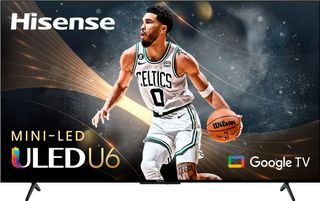
Best under $500
The Hisense U6K delivers an outstanding picture for under $500. Its Mini-LED backlighting offers spectacular contrast while its quantum dot filter ensures well-saturated colors.

Runner-up budget
It's a QLED with a lot to love, pushing some serious gaming legs on top of a 120Hz display with all the support for HDR standards. That's how Vizio's Quantum Pro Mini-LED TV makes itself known as a valiant option even at its under $700 price.
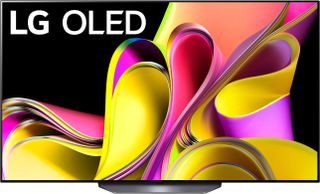
The best OLED TV
The LG B3 OLED gives you the greatness of LG's best OLED TVs at a surprisingly affordable price. It's not as cheap as the A2 OLED that can often be found for around $600, but this is a huge upgrade that we highly recommend.
The full list: Best budget TVs in detail
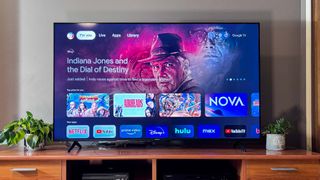
Specifications
Reasons to buy
Reasons to avoid
You can't have a list of the best budget TVs without mentioning the Hisense U6K. It might not have the peak levels of brightness that the Hisense U8K has, but it sports a Mini-LED backlight that enables enables better contrast with above-par black levels and a quantum dot for color saturation. Tack on Google TV and VRR support for consoles, and you’re getting a lot of the best features at a much lower price point.
Why we think it's better than all the rest is that, thanks to its Mini-LED backlight system, the U6K has much better brightness and contrast and a lower likelihood of the dreaded Dirty Screen Effect from non-uniform lighting elements compared to the competition. It also uses Google TV which, although a bit temperamental, is one of the slickest smart TV platforms available.
If you want the best bang for your buck, the Hisense U6K can’t be beat.
Read our full Hisense U6K Mini-LED TV review.
Best under $1,000
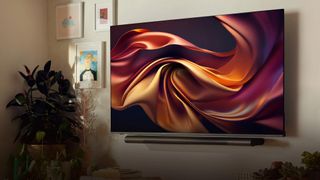

Specifications
Reasons to buy
Reasons to avoid
Though not often found among the best TVs slots, Vizio is making a swift comeback. Off the back of its purported purchase via Walmart, Vizio is delivering on some sound display designs as seen with its $698 Quantum Pro Mini-LED TV. That's right, this one's powered by Mini-LED backlighting and uses a QLED panel to meet some high brightness potentials, measured at 877 nits in HDR content and 862 nits for standard.
But what about it's gaming potential? The Vizio Quantum Pro wouldn't be featured among the best 4K TVs without some serious gaming chops and it truly delivers. Where most TVs fall flat these days, the Quantum Pro brings four HDMI 2.1 inputs for the latest gaming features like VRR and ALLM. Aside from that, it also uses a 120Hz refresh rate with an input lag of 14.3ms. Not the best, but it's more than reasonable for the price.
And you're not left out on the curb for HDR support either, wrangling together Dolby Vision, HLG, HDR10, and HDR10+ for the best suite of performance when it comes to the format. As for audio, though, you might want to consider one of the best Dolby Atmos soundbars to bring its middling 20W of power to a far better crescendo.
Read our full Vizio Quantum Pro review
Best Budget OLED
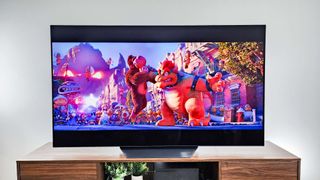
Specifications
Reasons to buy
Reasons to avoid
It's the most expensive TV you're going to find on this list, but the LG B3 OLED is truly a force to be reckoned with in the budget TV space. Instead of spending upwards of two grand on an OLED, the B3 OLED offers all the benefits of the panel technology (and more) for right around $1,000.
For folks looking for the barest of bones OLED, the A2 OLED is great too, but the B3 goes well-above its little brother by adding a 120Hz native panel, two HDMI 2.1 ports and a better processor to the mix.
In terms of performance, it hits a peak brightness of 635 nits (about the same as the Hisense and TCL) but has the ability to cover 99.9724% of the Rec709 color space and a color accuracy (measured by a Delta E value) of 1.8943. For gamers, cinephiles and really anyone who wants an amazing TV experience, these are some of the best numbers you're going to find at this price point.
Read our full LG B3 OLED review.
Best Budget TVs Test Results
| TV | Peak Brightness (tested) | Delta-E (tested) | BT2020 Color Volume (tested) | Input Lag (tested) |
| LG B3 OLED | 652.80 nits | 1.8943 | 73.87% | 10.1ms |
| Roku Plus Series | 648.10 nits | 2.6011 | 80.54% | 11.5ms |
| Hisense U6K | 525.14 nits | 3.5783 | 80.98% | 10.2ms |
Other budget TVs we tested
- TCL S4 4K TV: The TCL S4 is often name-dropped when talking about budget TVs, but our testing shows that this mainstay isn't all it's cracked up to be. Its SDR brightness was less than half of the Hisense U6 and the U6 blew it out of the water on color saturation. For the money, the U6 is the better option.
- LG UR9000: Our reviewers were unimpressed with this TV's poor audio and color saturation.
- Samsung CU7000: Low brightness and poor color saturation should keep you away from this ultra-budget set from Samsung.
- Samsung CU8000: It has an affordable price tag and low latency that gamers will like, but the upscaling, motion processing and overall picture performance leaves a lot to be desired.
- Amazon 2-Series TV: This HD model has a decent built-in smart platform, but otherwise has poor performance across the board.
How to choose the best budget TV for you
Buying a budget TV definitely means making a few sacrifices (2,000-nit brightness on a budget TV? No way) but hopefully now you know that you can find the essential features at an affordable price. So what should you be on the lookout for when buying a budget TV model?
4K resolution: 4K resolution is so affordable, and the quality so much better than 1080p or 720p, that we always recommend going for 4K. Unless you're on a shoestring budget, getting a proper 4K TV won't even cost you much money, but you will notice the difference.
Screen size: You may not always be able to score a premium 65-inch TV for under $500, but you can still get a decent 55-inch model, so don't settle for some dinky 43-inch set unless it's the right size for the space.
HDR support: If there's one feature we recommend, it's high dynamic range (HDR). Even basic HDR support provides better color, brighter highlights and richer shadows, giving you a better picture in every respect. If you can find a set with Dolby Vision, that's even better, but you may pay more for that feature.
Connectivity: More HDMI ports are always better, so you don't find yourself having to awkwardly swap plugs on the TV every time you want to fire up a Blu-ray or jump into a game.
Gaming: For affordable gaming TVs, we recommend looking for sets with higher refresh rates of 60Hz, but the latest Xbox Series X and PS5 consoles can actually go higher. Lag time is another concern, so check out individual reviews to find sets that have a lag time of shorter than 20 milliseconds for the best performance.
What features are worth paying more for?
Why you can trust Tom's Guide
Budget TVs are great. They are. And yet, you might be wondering what you're missing by not spending the big bucks on a flagship model. Unfortunately, there are a few features that you just simply can't find on a budget TV model unless you're willing to flex the budget a bit.
Screen size: This one is a given. Unfortunately, you're not going to get a 75-inch or 85-inch TV for the same price as a 55-inch model. Bigger screens cost more money. It's like the law of gravity. Now, you can find a 75-inch TCL 4-Series for around the cost of a 65-inch 6-Series, but there are trade-offs in other areas to get that bigger size.
Class-leading picture quality: It's a shame, but you can't get class-leading picture quality on a budget. You can get close (see: the TCL 6-Series) but you'll never get an LG OLED or Samsung QLED TV's performance at the same price as, say, the TCL 5-Series. That means missing out on the best contrast, best color saturation, best upscaling and motion handling, and the best speed when navigating the UI.
Sound quality: Oof, we've all heard awful-sounding TVs and they can ruin the whole experience. While today's budget TVs do a lot of things well, sound quality isn't one of them. If you're going for something that's super cheap, expect weak and tinny sound from 10W speakers. The good news? You can buy a super cheap TV and then add one of the best soundbars later to get better audio.
How we test the best budget TVs
Evaluating TVs is about more than just kicking back to watch a movie. We lab test every TV, measuring color gamut, color accuracy and brightness to objectively see which sets are the best for these key indicators. We also test for lag time – a key detail for gaming – measuring to the millisecond how long it takes for content to travel from the original source to the screen. We use these results to make numbers-based comparisons about color and display quality.
We also spend time with each set for real-world evaluation and see how our lab results translate into more subjective performance. We also compare sets side by side and view samples from the latest movies, specialized test patterns that highlight strengths and weaknesses of each display, and a range of content across several sources. With that information, we can tell you which TVs look best, sound best and offer the best viewing experience.
Finally, we evaluate the smart TV functions and apps for each TV, looking at everything from the remote control design to the voice interaction.
We put all of that data together with our real-world testing and stack it against the price of the TV. The result is a score that we feel best represents the totality of that model, and how well it stands up against its contemporary rivals. A TV that scored highly five years ago may not score as highly against a newer model, but we do our best to update reviews when newer models become available.
Interested in a specific TV brand, price range or screen size? Check out our picks for the best TVs in each.
Best TVs | Best 4K TVs | Best smart TVs for streaming | Best TVs for gaming
The best TVs under $1000 | The best TVs under $500 | Best Budget TVs
Best TV brands | Best Samsung TVs | Best TCL TVs | Best LG TVs | Best Roku TVs | Best OLED TVs | Best QLED TVs | Best 8K TVs | Best HDMI 2.1 TV | Best TVs with ATSC 3.0 | Best TVs with Chromecast
The smallest smart TVs | Best 43-inch TVs | Best 50-inch TVs | Best 55-inch TVs | Best 65-inch TVs | Best 70-inch TVs | Best 75-inch TVs | Best 85-inch TVs
Sign up to get the BEST of Tom's Guide direct to your inbox.
Get instant access to breaking news, the hottest reviews, great deals and helpful tips.

Nick Pino heads up the TV and AV verticals at Tom's Guide and covers everything from OLED TVs to the latest wireless headphones. He was formerly the Senior Editor, TV and AV at TechRadar (Tom's Guide's sister site) and has previously written for GamesRadar, Official Xbox Magazine, PC Gamer and other outlets over the last decade. Not sure which TV you should buy? Drop him an email or tweet him on Twitter and he can help you out.
-
AmyInNH Absurd assumptions of relevance of particular features. Size, for instance.Reply
Tom's Guide is becoming so badly tainted by this, it's degrading to "enthusiast" interests.